Related Research Articles

Georgian architecture is the name given in most English-speaking countries to the set of architectural styles current between 1714 and 1830. It is named after the first four British monarchs of the House of Hanover, George I, George II, George III, and George IV, who reigned in continuous succession from August 1714 to June 1830.
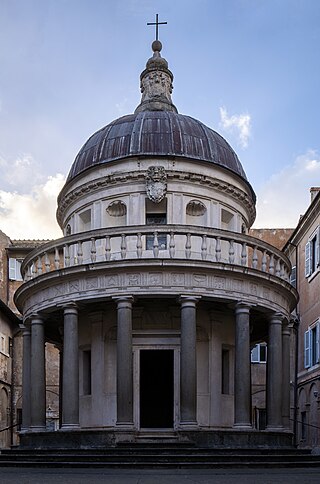
Renaissance architecture is the European architecture of the period between the early 15th and early 16th centuries in different regions, demonstrating a conscious revival and development of certain elements of ancient Greek and Roman thought and material culture. Stylistically, Renaissance architecture followed Gothic architecture and was succeeded by Baroque architecture and neoclassical architecture. Developed first in Florence, with Filippo Brunelleschi as one of its innovators, the Renaissance style quickly spread to other Italian cities. The style was carried to other parts of Europe at different dates and with varying degrees of impact.

Classicism, in the arts, refers generally to a high regard for a classical period, classical antiquity in the Western tradition, as setting standards for taste which the classicists seek to emulate. In its purest form, classicism is an aesthetic attitude dependent on principles based in the culture, art and literature of ancient Greece and Rome, with the emphasis on form, simplicity, proportion, clarity of structure, perfection, restrained emotion, as well as explicit appeal to the intellect. The art of classicism typically seeks to be formal and restrained: of the Discobolus Sir Kenneth Clark observed, "if we object to his restraint and compression we are simply objecting to the classicism of classic art. A violent emphasis or a sudden acceleration of rhythmic movement would have destroyed those qualities of balance and completeness through which it retained until the present century its position of authority in the restricted repertoire of visual images." Classicism, as Clark noted, implies a canon of widely accepted ideal forms, whether in the Western canon that he was examining in The Nude (1956).

In the visual arts, style is a "... distinctive manner which permits the grouping of works into related categories" or "... any distinctive, and therefore recognizable, way in which an act is performed or an artifact made or ought to be performed and made". Style refers to the visual appearance of a work of art that relates to other works with similar aesthetic roots, by the same artist, or from the same period, training, location, "school", art movement or archaeological culture: "The notion of style has long been historian's principal mode of classifying works of art".
Neoclassical or neo-classical may refer to:

Victorian architecture is a series of architectural revival styles in the mid-to-late 19th century. Victorian refers to the reign of Queen Victoria (1837–1901), called the Victorian era, during which period the styles known as Victorian were used in construction. However, many elements of what is typically termed "Victorian" architecture did not become popular until later in Victoria's reign, roughly from 1850 and later. The styles often included interpretations and eclectic revivals of historic styles (see Historicism). The name represents the British and French custom of naming architectural styles for a reigning monarch. Within this naming and classification scheme, it followed Georgian architecture and later Regency architecture and was succeeded by Edwardian architecture.

Decorum was a principle of classical rhetoric, poetry, and theatrical theory concerning the fitness or otherwise of a style to a theatrical subject. The concept of decorum is also applied to prescribed limits of appropriate social behavior within set situations.

The following outline is provided as an overview of and topical guide to classical architecture:
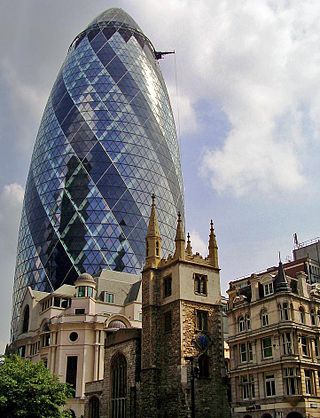
The architecture of England is the architecture of modern England and in the historic Kingdom of England. It often includes buildings created under English influence or by English architects in other parts of the world, particularly in the English and later British colonies and Empire, which developed into the Commonwealth of Nations.

The Italianate style was a distinct 19th-century phase in the history of Classical architecture. Like Palladianism and Neoclassicism, the Italianate style combined its inspiration from the models and architectural vocabulary of 16th-century Italian Renaissance architecture with picturesque aesthetics. The resulting style of architecture was essentially of its own time. "The backward look transforms its object," Siegfried Giedion wrote of historicist architectural styles; "every spectator at every period—at every moment, indeed—inevitably transforms the past according to his own nature."
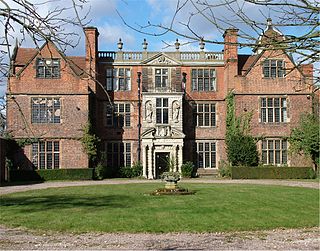
The Jacobean style is the second phase of Renaissance architecture in England, following the Elizabethan style. It is named after King James VI and I, with whose reign it is associated. At the start of James' reign, there was little stylistic break in architecture, as Elizabethan trends continued their development. However, his death in 1625 came as a decisive change towards more classical architecture, with Italian influence, was in progress, led by Inigo Jones. The style this began is sometimes called Stuart architecture, or English Baroque.

Neoclassical architecture, sometimes referred to as Classical Revival architecture, is an architectural style produced by the Neoclassical movement that began in the mid-18th century in Italy, France and Germany. It became one of the most prominent architectural styles in the Western world. The prevailing styles of architecture in most of Europe for the previous two centuries, Renaissance architecture and Baroque architecture, already represented partial revivals of the Classical architecture of ancient Rome and ancient Greek architecture, but the Neoclassical movement aimed to strip away the excesses of Late Baroque and return to a purer, more complete, and more authentic classical style, adapted to modern purposes.

Renaissance Revival architecture is a group of 19th-century architectural revival styles which were neither Greek Revival nor Gothic Revival but which instead drew inspiration from a wide range of classicizing Italian modes. Under the broad designation Renaissance architecture 19th-century architects and critics went beyond the architectural style which began in Florence and Central Italy in the early 15th century as an expression of Renaissance humanism; they also included styles that can be identified as Mannerist or Baroque. Self-applied style designations were rife in the mid- and later 19th century: "Neo-Renaissance" might be applied by contemporaries to structures that others called "Italianate", or when many French Baroque features are present.

Silesian architecture is the name given to the constructions made in Silesia throughout time, and those by Silesian architects worldwide. The name is also applied to buildings made within its geographical limits before the constitution of Silesia as a duchy or before this name was given to those territories, and largely depends on the historical moment. Due to historic, geographic and generational diversity, Silesian architecture has known a host of influences.
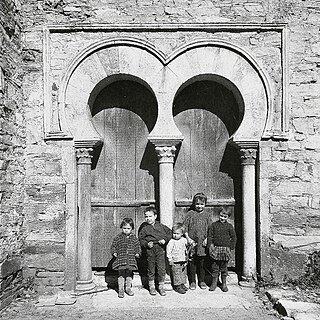
Mozarabic art is an early medieval artistic style that is part of the pre-Romanesque style and is linked to the kingdom of León. It was developed by the Hispanic Christians who lived in Muslim territory and in the expansion territories of the León crown, in the period from the Muslim invasion (711) to the end of the 11th century. During this period, disciplines such as painting, goldsmithing and architecture with marked Caliphate influences were cultivated in a context of medieval coexistence - Christian, Hebrew and Muslim - in which the territories were constantly changing in size and status. Other names for this artistic style are Leonese art or repopulation art.
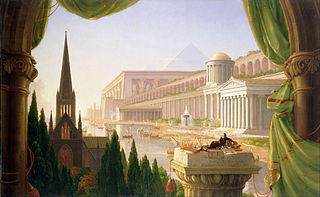
Historicism or historism comprises artistic styles that draw their inspiration from recreating historic styles or imitating the work of historic artists and artisans. This is especially common in architecture, where there are many different styles of Revival architecture, which dominated large buildings in the 19th century. Through a combination of different styles or the implementation of new elements, historicism can create completely different aesthetics than former styles. Thus, it offers a great variety of possible designs.
Polite architecture, or "the Polite" in architectural theory comprises buildings designed to include non-local styles for aesthetically pleasing decorative effect by professional architects. The term groups most named current architectural styles and can be used to describe many non-vernacular architectural styles. Irreconcilable architectural practices include Functionalism and Brutalism. Common styles often associated with polite architecture include Victorian, Gregorian, Gothic and Classical.

An architectural style is a classification of buildings based on a set of characteristics and features, including overall appearance, arrangement of the components, method of construction, building materials used, form, size, structural design, and regional character.

Stripped Classicism is primarily a 20th-century classicist architectural style stripped of most or all ornamentation, frequently employed by governments while designing official buildings. It was adopted by both totalitarian and democratic regimes. The style embraces a "simplified but recognizable" classicism in its overall massing and scale while eliminating traditional decorative detailing. The orders of architecture are only hinted at or are indirectly implicated in the form and structure.

The Art Nouveau architecture in Riga makes up roughly one third of all the buildings in the centre of Riga, making Latvia's capital the city with the highest concentration of Art Nouveau architecture anywhere in the world. Built during a period of rapid economic growth, most of Riga's Art Nouveau buildings date from between 1904 and 1914. The style is most commonly represented in multi-storey apartment buildings. Stylistic influences derived not least from present-day Austria, Finland and Germany, while the establishment of a faculty of architecture in Riga in 1869 was instrumental in providing a local cadre of architects. This included, but was not limited to, some of the first formally trained ethnic Latvian architects. As elsewhere, the Art Nouveau movement in Riga was driven by a desire to express greater individuality, local attachment and a more rational kind of architecture than that which had dominated during the 19th century. Stylistically, the Art Nouveau architecture of Riga can be further divided into four different stages: Eclectic, Perpendicular, National Romantic; and Neo-Classical.
References
- ↑ Rykwert, Joseph (1990). "Review of English Neo-Classical Architecture". Eighteenth-Century Studies. 24 (1): 113–117. doi:10.2307/2738989. ISSN 0013-2586.